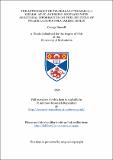Files in this item
The autecology of pylaiella littoralis (L.) kjellm. at St. Andrews, Scotland with additional information on the life cycle of pylaiella rupincola (Aresh.) kylin
Item metadata
| dc.contributor.advisor | Blackler, Margaret Constance Helen | |
| dc.contributor.author | Russell, George | |
| dc.coverage.spatial | 126 p. | en_US |
| dc.date.accessioned | 2018-06-22T15:24:25Z | |
| dc.date.available | 2018-06-22T15:24:25Z | |
| dc.date.issued | 1959 | |
| dc.identifier.uri | https://hdl.handle.net/10023/14490 | |
| dc.description.abstract | (1) The nomenclature and position of Pylaiella littoralis in classifications of the Phaeophyta are, briefly described, the value of the species as a subject for autecological investigation is assessed and the aims of the investigation stated, (ii) The distribution of P. littoralis in (a) the northern hemisphere and (b) on the British coasts is reviewed and the species is found to be both common and widespread in all areas. (iii) The morphology of P. littoralis is briefly described, the chief features being the cell wall, cell contents, cell dimensions, cable rolling, sporangia (structures and dimensions) and growth areas. (iv) The life cycle of P. littoralla is reviewed and the findings of other workers compared with those for the species at St. Andresws. The life cycle of P. littoralis at St. Andrews is deduced from field observations, studies in culture and cytological evidence and hot found to be very different from the pattern typical of the filamentous Ectocarpaceae. (v) The stages of early growth from the zoospore to the age of six weeks are described on the basis of observations made on the species growing in culture. (vi) The distribution of P. littpralis at St. Andrews is found to fall into several natural communities, These are (1) a permanent lithophytic community growing on rock ridges at about mean tide level, (2) a community growing on boulders at the foot of a north-facing cliff, (3) an epiphytic community found in summer and autumn on open parts of the shore and in winter and spring in pools at, or slightly below, high water of neap tide's, (4) a community growing on mud, stones or Fucus ceranoides within the confines of the harbour at St. Andrews and lastly, (5) a salt marsh community at the estuary of the River Eden some three miles to the north of St. Andrews. The different species of algae and, to a lesser extent, of fauna associated with the Pylalella in these communities are described. The more important environmental conditions are also described and, where possible, measured. Additional information when relevant to the species in any of the communities is given in the form of short notes. (vii) The differehoes between the Pylaiella plants from the three main communities (i.e. lithophytic, epiphytic and harbour) are described from morphological features and from the results of transplant experiments in the field and in culture. (viii) The subspecific taxonomy of littoralia is reviewed and the plants from the three main communities at St. Andrews identified. (ix) The life cycle, morphology and ecology of Pylaiella rupincola is reviewed and the results of personal investigation of the species given, the material used in the investigation having been sent from Kristineberg, Sweden. (x) The two main features arising from the present study are discuissed. These are (1) the close relationship between distribution, environmental conditions, and life cycle in separate from (xi) The various conclusions reached from the investigation are given; of these the most important are:- (1) The gametophyte generation of is produced by, germination of the zoospores released from unilocular sporangia. This generation is small in size, seasonal (spring) in distribution, and, relative to the sporophyte, of uncommon occurrence at St. Andrews. (2) Environmental conditions affect the growth, fertility and the types of sporangia borne by P. littoralis but changes in the environmental conditions are not accompanied by morphological alteration and are generally detrimental to the species, (3) The ecological races of littoralis cannot be described in the nomenclature of orthodox taxonomy. (4) As a result of the investigation carried out on P. rupincola it is concluded that it should no longer be separated from P. littoralis on the grounds suggested by Kylin (1937). | en_US |
| dc.language.iso | en | en_US |
| dc.publisher | University of St Andrews | |
| dc.subject.lcc | QK931.R8 | en |
| dc.subject.lcsh | Marine ecology | en |
| dc.title | The autecology of pylaiella littoralis (L.) kjellm. at St. Andrews, Scotland with additional information on the life cycle of pylaiella rupincola (Aresh.) kylin | en_US |
| dc.type | Thesis | en_US |
| dc.contributor.sponsor | Carnegie Trust for the Universities of Scotland | en_US |
| dc.type.qualificationlevel | Doctoral | en_US |
| dc.type.qualificationname | PhD Doctor of Philosophy | en_US |
| dc.publisher.institution | The University of St Andrews | en_US |
This item appears in the following Collection(s)
Items in the St Andrews Research Repository are protected by copyright, with all rights reserved, unless otherwise indicated.

